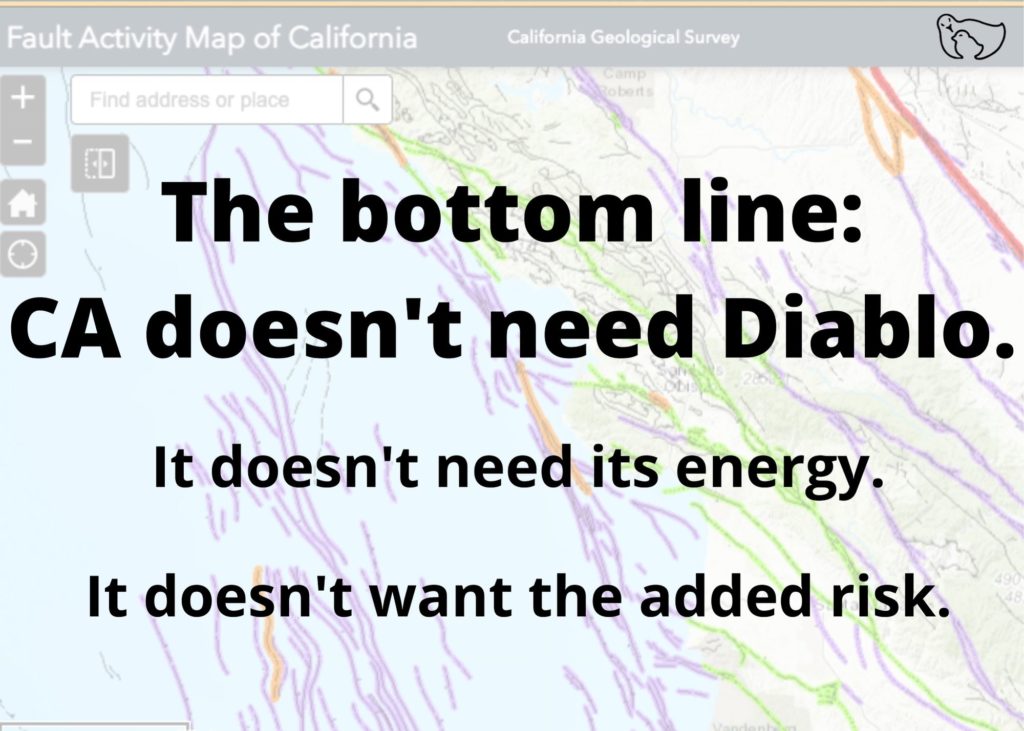The group draws on nuclear and energy experts to lay out the truth.

On June 15, Mothers for Peace invited nationally-renowned nuclear energy experts to discuss Governor Gavin Newsom and U.S. Senator Dianne Feinstein’s attempts to funnel billions of dollars towards extending Diablo Canyon’s operation past its scheduled decommission by 2025.
In a recent op-ed in the Sacramento Bee, Sen. Feinstein stated, “Closing Diablo Canyon would remove 18,000 gigawatt-hours from the grid, nearly 10% of the state’s electricity generation.” She continued, “Moreover, the plant generates 15% of the state’s carbon-free electricity.”
Annual generation provided by current energy projects alone will produce more electricity for the California grid yearly than Diablo does currently. At the MFP briefing, Tim Judson, Executive Director of Nuclear Information & Resource Services (NIRS), noted, “The joint proposal by PG&E, labor and environmental organizations ensured the orderly and reliable phase-out of Diablo Canyon with greenhouse gas-free resources.” putting California on track to produce 10 times the amount of energy than Diablo has been historically capable of (see below).

Robert Freehling, an Energy Consultant, expanded on why Diablo generation needed to be shut down, outlining three key points:Load Reduction: A drop in customers forced PG&E over the last several years to sell off its energy resources, removing its natural gas first, and then shedding 40% of its renewable energy, dropping from 22,000 gigawatt-hours to 12,000 gigawatt-hours between 2016-2020. Since Diablo produces an average of 17,000 gigawatt-hours per year, PG&E had more renewable in its portfolio than the full value of Diablo. By 2020, PG&E dropped 10,000 gigawatt-hours of energy. (PG&E increased its renewable supply after 2020 to 16,000 gigawatt-hours.)
If PG&E hadn’t sold off its renewable resources and half its hydropower to the Community Choice Aggregations (CCA), it would currently have approximately 25,000 gigawatt-hours of carbon-free generation resources – that’s out of a total need of 33,000 gigawatt-hours. The bottom line is that PG&E dropped its renewables to keep Diablo online. Rather than replacing Diablo with renewables, PG&E replaced renewables with Diablo Canyon.
Expansion of Renewables: In 2020, there was 5.5 times more utility-scale renewable energy than Diablo produced. In addition, rooftop solar provides 12,000 megawatts already, which is six times the capacity of Diablo, with an additional 1,000 megawatts added every year. Tim Judson observed that by 2026, the CCAs will add about 80% of renewable energy.
Energy Efficiency: In 2015, State Law SB 350 required utilities and the state to double the additional energy efficiency, adding a Diablo Canyon’s worth of carbon-free energy savings every three years.
The California Energy Commission’s 2020 Total System Electric Generation report illustrates that California is on track to produce enough renewables without Diablo. As indicated in the table below, there were 116,400 megawatt-hours of GHG-free resources in 2020.
2020 GHG-Free Resources – Refuting Feinstein’s Scam Analysis
| Resource | GWh |
| RPS Renewables | 63,665 |
| Large Hydroelectric | 17,938 |
| Customer Solar PV | 18,517 |
| Nuclear | 16,280 |
| Efficiency | |
| Total GHG-Free | 116,400 |
| Diablo Canyon in 2018 | 18,268 (15.7%) |
Beyond the growth of GHG-free resources already online, Diablo’s inflexible base flow generation would block the continued growth of renewables, cause transmission problems – as we saw in the 2020 power outage – and increase rates.
Energy storage capacity is also expanding per The Integrated Resource Plan (IRP), increasing renewables’ ability to meet California’s energy needs. In total there will be almost 15,000 megawatts in battery storage which includes new battery storage of 12,138 megawatts, plus 973 in pump storage, that’s on top of 2,573 pump storage to come on line by 2030, creating greater reliable capacity. This will also be a factor in preventing the type of power outage the state experienced in 2020.
In her op-ed, Sen. Feinstein neglected to disclose Diablo’s proximity to a web of fault lines, including the dangerous Hosgri fault. Sitting 2.5 miles offshore from Diablo, it is capable of earthquakes up to a magnitude of 7.5. Diablo is not built to withstand such a quake. Daniel Hirsch, President of the Committee to Bridge the Gap, explained that an earthquake of this magnitude could wipe out a large portion of the state of California for generations. Hirsch asserts, “This proposal by Newsom, who helped negotiate a deal in 2016, to break the deal and let the plant run longer simply places huge numbers of people at great risk, and that is what is at stake here.”
Sen. Feinstein likewise downplayed the costs of spent nuclear fuel storage, amounting to an additional $350 million worth of storage construction necessary for irradiated fuel generated after 2025, not including health and environmental costs.
Further, the daily operation sees Diablo increasing regional ocean temperatures and destroying local marine ecosystems.
And continual deferral of maintenance and monitoring in anticipation of closure further increases the risk of mishaps. The advanced age of the plant explains why Diablo Canyon’s Unit 1 reactor has been cited by the NRC as having one of the most embrittled reactors in the United States.
Newsom and Feinsten must seriously consider the risks involved with prioritizing Diablo’s nuclear energy, a disaster waiting to happen, over California’s accelerating developments in renewables, efficiency, and storage.
To watch the media briefing explaining why Diablo Canyon needs to shut down in 2025, as PG&E has agreed to do, click here.
